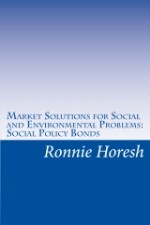Free riding
Much of the criticism of Social Policy Bonds has centred on the free rider problem. I should make clear at the outset is that Social Policy Bonds are intended to be the most effective and efficient way of solving those complex, long-term, social and environmental problems that currently remain unsolved, and many of which aren't even being addressed, as they are thought to be intractable.
The goals that Social Policy Bonds are best suited for are those that are:
- long term,
- broad,
- likely to need a mix of diverse, adaptive approaches to their achievement, and
- resistant to any current or envisaged efforts by policymakers to their achievement.
If Social Policy Bonds are to be of value, then, they need not be elegant in an economic sense. They just need to better than alternative approaches, including the approach of not doing anything. Which is all to say that, if free riding does occur under a bond regime, it becomes problematic only if it's so significant that it makes the bond concept less effective than current or potential alternative efforts to achieve our most challenging social and environmental goals.
The first thing is to note that free riders gain only if the value of their bonds rises; that is, if the goal is seen to be more likely to be reached, which usually means that something is being done to achieve the goal. The real difficulty would arise if so many bonds are owned by passive investors (would-be free riders) that the goal remains unachieved as a result of their passivity.
And at first sight, it would appear that the more bonds in the hands of would-be free riders, the less likely that the targeted goal will be achieved quickly. The market value of all the bonds will therefore fall. As it falls, so the potential rewards from holding each bond rises, so that more people would become interested in buying the bonds. If the price keeps falling, the would-be free riders will be tempted to sell their bonds to these buyers. Some might be tempted to become active investors themselves, rather than sell to such investors. The bonds are worth most to those prepared to do something to help advance the targeted goal. Nevertheless, there will certainly be some who will hang on to their bonds, and it is likely that, yes, there will be an irreducible number of bonds in the hands of free riders, who will profit as the targeted goal comes closer to achievement. The question is whether these holdings would be sufficiently large to make Social Policy Bonds less efficient than alternative policies.
It's unlikely that would-be passive investors will hold a significant proportion of the bonds issued, because that would devalue the bonds in the market. So it's more likely that the bonds held by would-be free riders will be distributed amongst a large number of people with small holdings. They would have no incentive to collude with each other for the same reason. With a low and falling bond price, would-be active investors, eyeing the total number of these bonds, could make offers greater than the current value to these small, passive, investors, and the result would be aggregation of holdings into a holding sufficiently large, and bought at sufficiently low cost, to encourage the holder to work to achieve the targeted goal; that is, to be an active investor.
Important to remember is that our goal is not to minimise free riding, nor to create policies that generate no free riding. Most policies do have an element of free riding, in the sense of people taking advantage of the efforts others have made to supply some collective good without actually contributing themselves. Society accepts even spectacularly egregious cases of free riding, such as rewarding property owners when transport infrastructure is extended to their locale. Corporate executives holding some proportion of their company's shares will try to maximise company sales or profits and will benefit by doing so - but so too will passive shareholders and the fact that they do so is both socially acceptable, and has no demonstrable disincentive effect on those executives or the functioning of the company.
Social Policy Bonds are intended to solve urgent, huge social and environmental problems that we not only are currently failing to address, but that we also have no idea how to address. These include the non-negligible chance of nuclear conflict, the gruesome reality of actual war, natural or anthropogenic disasters, crime and illiteracy. Free riding is problematic only if it so diminishes the Social Policy Bond concept that it makes it less efficient or less effective that any other policy, including existing policy, or the non-policy of doing nothing. Most of us would not see as a downside that one result of, for example, successfully securing world peace for several decades is that some people could make a bit of cash without exerting themselves.
